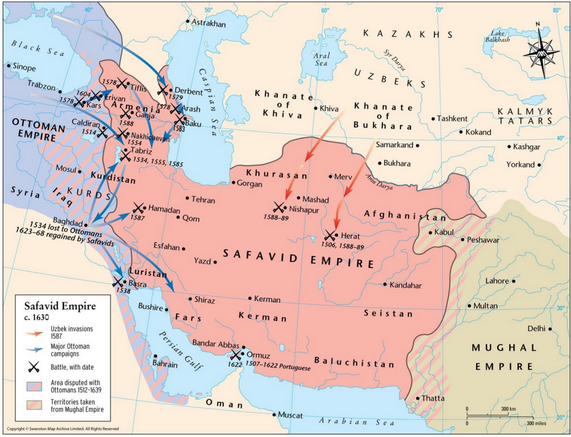Recent Period:1501- 1794 ~3 centuries


Rise of Strong Iranian Dynasties 1501 to 1798 C.E.
Safavid 1501-1736; Afsharid 1736-1796; Zandieh 1750-1794
- Safavid dynasty, (1501–1736), was one of the most significant ruling dynasties of Iran, and is often considered the beginning of modern Persian history. It was a major factor in the emergence of a unified national consciousness among the various ethnic and linguistic elements of Iran. After 900 years with the support of Shia Qizilbash warrior tribes Shah Ismail I replaced the Ak Koyunlu (Tatar) becomes first ruler of Safavid dynasty resembling Iran’s past glory. Especially during Shah Abbas reign, where he established Shite as the official religion of the country separating it from Sunni Arabs and stopping the Ottoman’s advancements with the 1639 peace treaty. Trade with the West and industry expanded, communications improved. He moved the capital to Esfahan and made it the center of Safavid architectural achievement. Nadir Shah Afshar ended Safavid Dynasty.
- Zandieh (1751-1794), The Zand rulers had been governing southern Iran from Shiraz, simultaneous with the final years of Safavids governing from Esfahan, central Iran.
- Afsharid Dynasty, (1736 – 96) Of Turkic origin; at its zenith, the dynasty stretched from Iraq to northern India, back to the size of the Samanian Dynasty of (819–999 CE). Founder Nadir Shah Afshar backed by an army of mostly Sunni Afghans, destroyed the armies of the Shii Safavid dynasty.
Nevertheless his religious and political attempts to eradicate Shii Safavid tradition ultimately failed. His empire collapsed after his death, and the territory collapsed to a partial area in the northeast. - In 1794 Agha Mohammad Khan Qajar put an end of the Zandieh dynasty.
- In 1796 Agha Mohammad Khan Qajar put an end of the Afsharid dynasty.
A Note about the Zandieh Dynasty and its Founder.
Saeed Naficy, dean of historians in Iran, and sociologist of the post-Islamic era, in his introduction to the “The History of Zandieh”, 1938 writes of the post- Islamic era of the history of Iranian governments: “Among the dynasties that have ruled Iran there have been none like the Zands who possessed chivalry, virtue, justice, ethics, kindness and were fond of their country, resentful of invading tribes and those appeasing them. Karim Khan Zand is one of the most beloved men of history and, besides kingship, he would be fit to serve as a model of ethics for mankind. “
Indeed, he & his descendants chose the title Advocate of the People (Vakilol Ro’aya) rather than Shah.
Karim Khan rebuilt Shiraz, his capital, and decorated it with new buildings including the Arg of Karim Khan, the Vakil Bazaar and the Kulah-e Farangi.He also restored the tombs of the medieval Persian poets Hafez and Saadi Shirazi. Until this day, the inhabitants of Shiraz honor Karim Khan.When following the Islamic Revolution of 1979 the names of the past rulers of Iran became a taboo, the citizens of Shiraz refused to rename the Karim Khan Zand Street and Lotf-Ali Khan Zand Street, the two main streets of Shiraz.
Karim Khan Zand sought to restore the pluralism, and multicultural, multi- religious and multi-ethnic character of Iran since ancient times. Thus he would honor his enemies or pardon them and give clemency, including the Qajar tribe, who being descended form the Mongols and Tartars, at that time could not speak Persian. Instead of killing his worst enemy, Agha Mohammad Khan Qajar (a.k.a. Kajar), chief the Qajar tribe, he treated him as a long-time guest at his court. Upon the death of Karim Khan, Agha Mohammad Khan Qajar escaped, collected his Qajar tribal backers to gain the throne. After sixteen years of such warfare, in 1794 when a young Zand prince, Loft Aly Khan, was in power, through treachery he overcame Loft Aly Khan, blinded him, dismembered then tortured him to death, had his wife raped and massacred the Zands at court in Shiraz.
